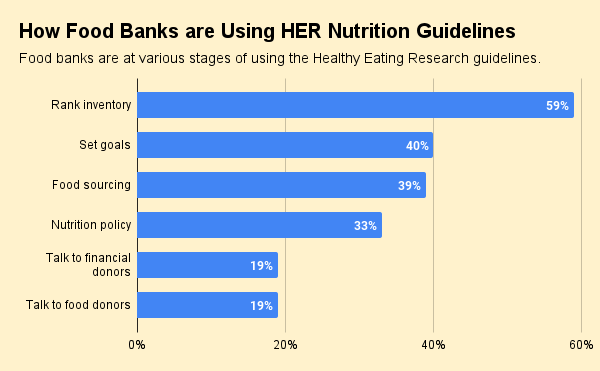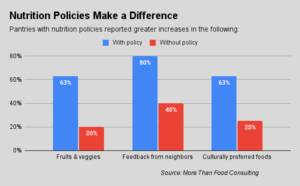In 2020, when Healthy Eating Research introduced nutrition guidelines designed to be easy for food banks to adopt and use, it hoped that Feeding America members would move toward the new framework over the next five years.
That wish appears to be coming true.
So far, 101 food banks across the country are using the HER guidelines, according to More Than Food Consulting, which drew upon information from Feeding America’s Network Activity Report and Partnership for a Healthier America to make its estimate.
Food banks are at different stages of adoption. In response to a May Feeding America survey, 61% of 85 responding food banks said they are currently using the guidelines, while 24% are planning to. Food banks are most likely (59%) to be using the framework to rank their food inventory, a trend that should result in greater agreement among food banks about what constitutes nutritious food.
Previously, a variety of different nutrition ranking systems and methodologies made it difficult to come by a common definition of healthy. For example, Feeding America’s Foods to Encourage (F2E) system placed foods in yes-no categories, while Supporting Wellness at Pantries (SWAP) used tiers of choose often (green), choose sometimes (yellow), or choose rarely (red).
 The HER guidelines most closely follow SWAP, ranking foods based on their levels of saturated fat, sodium and added sugar, and placing them into the categories of green, yellow or red. While some foods are easily ranked (i.e. produce is always green), others, like donated cans, require more effort, likely explaining why only 22% of food banks have so far ranked more than 76% of their inventory.
The HER guidelines most closely follow SWAP, ranking foods based on their levels of saturated fat, sodium and added sugar, and placing them into the categories of green, yellow or red. While some foods are easily ranked (i.e. produce is always green), others, like donated cans, require more effort, likely explaining why only 22% of food banks have so far ranked more than 76% of their inventory.
Other ways food banks are using HER: to set goals related to acquiring nutritious food (40%) and to make food sourcing decisions (39%). In addition, 33% of food banks have established nutrition policies based on the HER guidelines. Fewer are using the guidelines to educate financial donors (19%) or food donors (19%) about more impactful donating.
More Than Food Consulting noted that food banks are more likely than not to be in the planning stages for all these activities, pointing to a “critical juncture” in use of the guidelines. “There appears to be a lot of momentum to build on the work,” the report said.
One opportunity for growth is to support partner agencies in using the guidelines. Currently, 38% of food banks communicate with their agencies about the guidelines and 31% offer training on them. But most do not provide agencies with discounts or grant funding to acquire green or yellow food, nor do they plan to, highlighting “opportunities for growth,” the report said. – Chris Costanzo
Like what you’re reading?
Support Food Bank News








